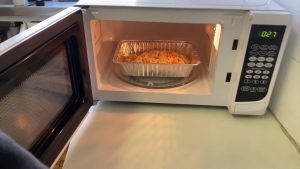Q: I often use aluminum trays for storing food and I have a question can you microwave aluminum tray?

can you microwave aluminium tray
A: Microwaving aluminum trays can be a convenient and efficient way to heat up food, but it’s important to know the proper techniques to avoid any potential hazards. Here’s a step-by-step guide on how to safely microwave food in an aluminum tray:
1. Check the tray for any damage or deformities. Cracked or bent trays should not be used in the microwave, as they can cause arcing, which is a dangerous electrical discharge.
2. Cover the aluminum tray with microwave-safe plastic wrap or a lid. This will prevent any food particles from coming into contact with the tray, which can cause arcing.
3. Place the tray in the microwave and set the power level to 50%. This will help prevent overheating and arcing.
4. Heat the food in the aluminum tray for the recommended time, checking on it frequently to ensure that it is not overheating.
5. Use oven mitts or tongs to remove the tray from the microwave, as it will be hot.
It’s important to note that not all aluminum trays are safe to use in the microwave. Trays made from aluminum foil or lightweight aluminum may not be suitable, as they can cause arcing. Also, aluminum trays with non-stick coating or metallic paint should not be used in the microwave as it can release harmful chemicals or toxins.
Additionally, it is always recommended to check the manufacturer’s instructions before using an aluminum tray in the microwave, as some manufacturers may not consider their trays safe for microwave use.
Another thing to keep in mind is that if you’re microwaving food that is high in oil or sugar, such as a pizza or a pastry, it’s best to use a microwave-safe plate or dish instead of an aluminum tray. These types of foods can cause arcing in the microwave and are a potential fire hazard.
In conclusion, microwaving food in an aluminum tray can be a convenient and efficient way to heat it up, but it’s important to use the proper techniques to avoid any potential hazards. Make sure to check the tray for any damage or deformities, cover it with microwave-safe plastic wrap or a lid, and use the recommended power level and heating time. And always keep in mind that some aluminum trays may not be suitable for use in the microwave, so be sure to check the manufacturer’s instructions before using them.